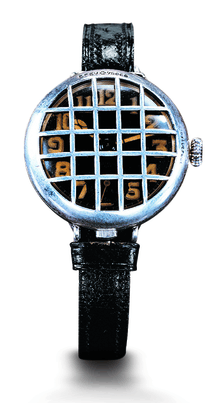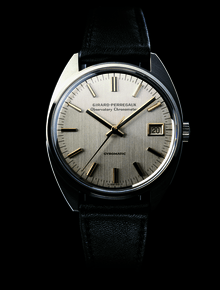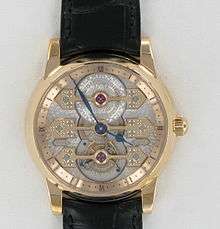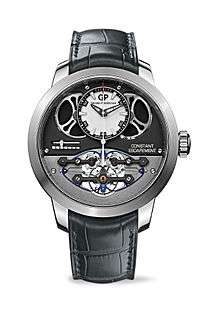Girard-Perregaux
 | |
| Subsidiary | |
| Industry | Watch Making, Haute Horlogerie |
| Founded | 1791 |
| Headquarters | La Chaux-de-Fonds, Switzerland |
Area served | Worldwide |
Key people | François-Henri Pinault |
| Products | Watches |
| Parent | Sowind group, Kering |
| Website |
www |
Girard-Perregaux (French: [ʒiʁaʁ pɛʁəɡo]) is a high-end Swiss watch manufacture with its origins dating back to 1791. It is situated in La Chaux-de-Fonds, Switzerland and is a part of the Sowind group, a subsidiary of Kering.[1]
History
In 1791, watchmaker and goldsmith Jean-François Bautte signed his first watches. He created a manufacturing company in Geneva grouping, for the first time ever, all the watchmaking facets of that time, which meant starting from the engineering of the watch all the way to the final hand-assembly and hand-polishing of each watch. In 1852, the watchmaker Constant Girard founded the Girard & Cie Firm in La Chaux-de-Fonds. He then married Marie Perregaux and the Girard-Perregaux Manufacture was born in 1856. In 1906, Constant Girard-Gallet, who took over control of the Manufacture from his father, took over the Bautte House and merged it with Girard-Perregaux & Cie.[2] Since then, the brand has pursued its activities by reinforcing from the 1980s its position in the domain of prestigious mechanical watches, Haute Horlogerie, under the lead of Luigi Macaluso. In 2011, Sowind Group, the holding incorporating Girard-Perregaux, became a subsidiary of Kering.

The Manufacture has approximately 80 patents in the watchmaking domain and is the originator of many innovative concepts.

- 1880: Constant Girard produced the first-ever major commercial production of a wristwatch, made for German naval officers and ordered by German Kaiser Wilhelm I for his German naval officers. Two thousand such watches were ordered and produced, which represents the first important commercialization of wristwatches.
- 1965: Girard-Perregaux designed the first mechanical movement at high frequency, with the balance beating at 36,000 vibrations/hour: the Gyromatic HF.[3]
- 1967: Girard-Perregaux receives the Centenary Award from the Astronomical Observatory de Neuchatel in recognition of the accomplishments of the Manufacture generally, and specifically for the Observatory Chronometer wristwatch that used the Gyromatic HF movement.
- 1970: Girard-Perregaux presents its first wristwatch to the world to be equipped with a quartz movement and the following year a second one which vibrates at 32,768 hertz, the frequency remaining the universal standard for quartz watches today.
- 2008: The brand presents prototypes of a constant-force escapement, distinguishing itself from all the other known escapements to this day. The first watch housing the constant escapement is presented in 2013.
Manufacture
Girard-Perregaux relies on being a manufacturer of movements and watches, and a manufacturer of cases and bands. They bring together some tens of different components: watchmakers, engineers, movement decorators, polishers, etc. This global approach, founded on the traditional know-how of the watchmaking craftsmanship, allows them to create and direct high quality watches and movements from the assembly stages all the way to the final encasement.[4]
Girard-Perregaux designs, manufactures and develops its own movements:
- a large collection of high-end watch making movements, of which the Tourbillon with three gold bridges is the emblematic piece.
- a complete range of mechanical movements at automatic reassembly (GP2700, GP3200, GP3300, GP4500), that can fit all the types of watches, all by serving as the base for the module constructions of mechanisms with complications.
- Quartz movements
Collections

Tourbillon with three gold bridges
It is the emblematic model of Girard-Perregaux.[5] In 1884, Constant Girard submitted to the United States Patent Office a patent of the design of the movement “Tourbillon with three gold bridges.” The three bridges were redesigned in the form of arrows and placed parallel to each other. The movement was no longer just a functional and technical element, but it also became an element of design in every way. In 1889, the Tourbillon with three gold bridges was awarded a gold medal at the Universal Exposition of Paris. In 1980, Girard-Perregaux decided to make 20 pieces to conform to the original of 1889: 1500 hours of work were necessary to create the first one. To celebrate its bicentenary in 1991, the company created a miniaturised wristwatch version of its famed Tourbillon with three gold Bridges. Since then, it is offered in different versions, and is sometimes associated with other watchmakers’ complications.
Main models
Out of the high-end watch collection, the most well known watches by Girard-Perregaux are: Vintage 1945 (with a rectangular case and a design inspired by an Art Deco style watch dating back to 1945), ww.tc (standing for worldwide time-control, this collection displays 24 time zones on the dial), Girard-Perregaux 1966, Laureato Evo³, and the Cat’s Eye (from the feminine line).
Girard-Perregaux is also famed for its signature complication piece: the Bi-Axial Tourbillon; it has released this complication in a number of limited-edition watches, including the 2012 release of the Bi-Axial Tourbillon DLC Titanium wristwatch which renovated the trend in line with modern titanium cases.[6]
Girard-Perregaux has recently introduced new models in both the Vintage 1945 and Girard-Perregaux 1966 collections for 2012, In respect of the Girard-Perregaux 1966, they have introduced a new Girard-Perregaux 1966 Full Calendar and a 1966 Chronograph which has been highlighted as a new grand classic by Girard-Perregaux themselves.[7] This Girard-Perregaux 1966 is a slightly larger faced model than previously issued by the watchmaker at 42 mm and may be a sign of the changing demands upon watchmakers by the watch enthusiast community.
As for the Vintage 1945, it is back with its three rose gold bridges and rectangular case design. The Vintage 1945 is powered by the Girard-Perregaux 9600-0019, Mechanical self-winding movement an all inhouse movement...[8]
In 2013, Girard-Perregaux presented its Constant Escapement, an answer to the waning power in traditional mechanical watches. The key component of this completely new design of the escapement is a buckled silicon blade thinner than a hair (14 µm) which acts as an energy micro-storage unit delivering constant impulses to the balance wheel.

Girard-Perregaux Museum
Since 1999, the Villa Marguerite, a building in La Chaux-de-Fonds from the beginning of the 20th century, has housed the Girard-Perregaux Museum. A selection of old watches and documents illustrating the history of the brand is presented there.
See also
References
- ↑ Socha, Miles, "PPR Takes Majority Stake in Sowind Group", Women's Wear Daily, July 4, 2011
- ↑ François Chaille, Girard-Perregaux
- ↑ François Chaille, Girard-Perregaux
- ↑ François Chaille, Girard-Perregaux
- ↑ website of the Fondation de la Haute Horlogerie, "Legendary watches"
- ↑ R.G. Holland, "Girard-Perregaux Bi-Axial DLC Titanium", October 2012
- ↑ The Watch Review Site, "Girard-Perregaux 1966 Chrongraph 42mm", March 2012
- ↑ The Watch Review Site, "Girard-Perregaux Vintage 1945 Three Gold Bridges", March 2012
Sources
External links
- Official website
- All the informations about Girard Perregaux
- Girard Perregaux Watch News and Reviews
- Website of the Fondation de la Haute Horlogerie
- Girard-Perregaux Brand Profile by Michael Weare
- Website of the Fondation de la Haute Horlogerie
- Girard-Perregaux Watch news and Reviews at The Watch Review Site